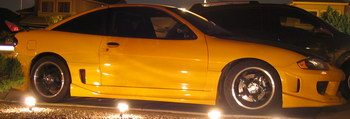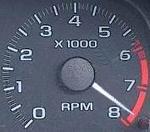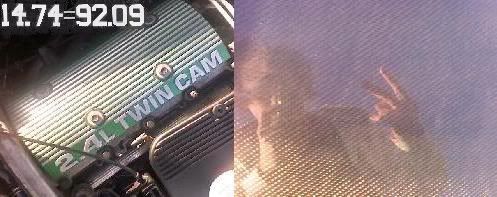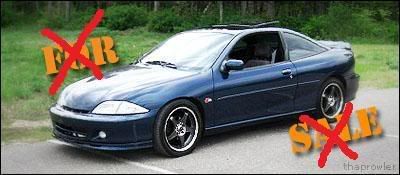i looked up the facts on ethanol vs regular dino gas, ethanol has less stored energy per litre than regular gas, 114,000 BTU for regular gas vs 112,000 for ethanol enriched gasoline.. only about 1.8% less .. but that adds up to fuel economy or power difference...
if we were talking E85, it has 27% less energy than regular gasoline.
anyone else thought about using a non-ethanol gasoline in their car? i think i may switch to shell v-power, since from what i've read and seen at the pumps they dont use ethanol in their premium fuels.
regular and mid grades seem to be 5-10% ethanol
14.82 @ 97 mph
The shell here uses 10% ethanol in all grades.

Quote:
anyone else thought about using a non-ethanol gasoline in their car? i think i may switch to shell v-power, since from what i've read and seen at the pumps they dont use ethanol in their premium fuels.
I'm actually thinking about running E85 and giving mine excessive amounts of timing.
According to Ford on their flexfuel vehicles, when running E85 rather than gas you get 5% less MPG and 5% more HP. If it was straight up E85, i'd bet on there being more MPG than gas cars. 27% less energy.... while this is n00bish research is true. But, look at the facts about gasoline and how much power there is in a gallon of gas. Then find out how much of that potential energy your car will actually use, and how much of it will get wasted into nothingness.

SHOoff (Tuner Bash Beer God) wrote:Quote:
anyone else thought about using a non-ethanol gasoline in their car? i think i may switch to shell v-power, since from what i've read and seen at the pumps they dont use ethanol in their premium fuels.
I'm actually thinking about running E85 and giving mine excessive amounts of timing.
According to Ford on their flexfuel vehicles, when running E85 rather than gas you get 5% less MPG and 5% more HP. If it was straight up E85, i'd bet on there being more MPG than gas cars. 27% less energy.... while this is n00bish research is true. But, look at the facts about gasoline and how much power there is in a gallon of gas. Then find out how much of that potential energy your car will actually use, and how much of it will get wasted into nothingness.
ive got the same plan, i was hoping to run e85 with an 086 head swap but idk if the head swap is gonna happen due to time and wanting to not rush it. this was gonna be on an n/a motor, i may still run e85 and bump the timing tho. also when i go boosted im def gonna be running e85, ive seen great results with it and ive been told by respected tuners that they love the stuff and would recommend it.

how much timing would you run? Whats too excessive? What would be a good rule of thumb for each octane or fule type?
oh dang I mispelled fuel!!
get on the dyno and find out.

brodycog wrote:how much timing would you run? Whats too excessive? What would be a good rule of thumb for each octane or fule type?
Depends on car to car. I have a different engine than you, so it would probably be different.
What would be too excessive? That would be when the engine blows up.

gmanz24 wrote:get on the dyno and find out.
Wow thanks for that well thought out answere. That was so helpfull LOL..
The word is out... E85 is the new Sunoco Purple (race gas)!
Go beyond the "bolt-on".
brodycog wrote:gmanz24 wrote:get on the dyno and find out.
Wow thanks for that well thought out answere. That was so helpfull LOL..
its the truth tho, what else should i tell you, crank that @!#$ till you pop a piston or not know if your making power anymore? honestly with hpt i raised my spark in a lot of areas just cuz. i assumed there was a safety net with gm's tune and i could add a slight few degrees without issues but im not gonna go nuts till its actually on the dyno and figure out if im makin more power.

ok that i can agree with.
there was a thread on breaking the e85 myth that it damages parts becasue its alcohol and i went through octane rating and ethanol content. basically i think if your someone into performance you should stay away from 87 octane even in a stock engine. especially name brand stations that are not quality. stick with shell or sunoco. shell ethanol content is not the same for the grades. 87-10% 89-5% 91-0". try searching it i made an explination of why its better to use 89+
Working on obtainting an M-Class license... ?? Hint: 2 wheels.
^This is where the old rule of octane for a given static-compression comes to mind... Which is: Whatever your static compression is, move the decimal one place to the right & you have the minimum octane you should run in your engine.
Since the idea of using knock-sensing engine management to prevent engine damage is put to use to also allow lower octane fuels to be run, so as to reduce the emissions produced & meet EPA mandates of all new vehicles (since '72) to be able to run 87-octane unleaded fuel, it only makes sense to run what would be the ideal octane to run with the given static compression if there weren't any knock-sensing spark timing control equipment involved. That way you'd get the most possible out of your engine without the management hapering performance by trying to compensate for fuel of a less than ideal octane.
Go beyond the "bolt-on".
10% is not enough to affect anything. Trust me I have been using it for the past 8 yrs now. However E-85 can be gold boosted cars if they are tuned to run it. I guess having ethanol around is about the only perk of living in IA

FORGET GIRLS GONE WILD WE HAVE GOVERNMENT SPENDING GONE WILD!
Wade Jarvis wrote:10% is not enough to affect anything. Trust me I have been using it for the past 8 yrs now. However E-85 can be gold boosted cars if they are tuned to run it. I guess having ethanol around is about the only perk of living in IA
That's because of the cooling effect alcohol has as it vaporizes. Whatever it's in contact with (Including air-charge) has it's heat drawn away, essentually acting like an additional intercooler. And as we all know... from arguements over the gain seen by outside air versus under-hood air... the cooler the aircharge entering the cylinder, the more power produced when fuel is mixed with the increased content of oxygen, then compressed & ignited. Because cooler air contains more oxygen. But then, y'all already knew that!
Go beyond the "bolt-on".






